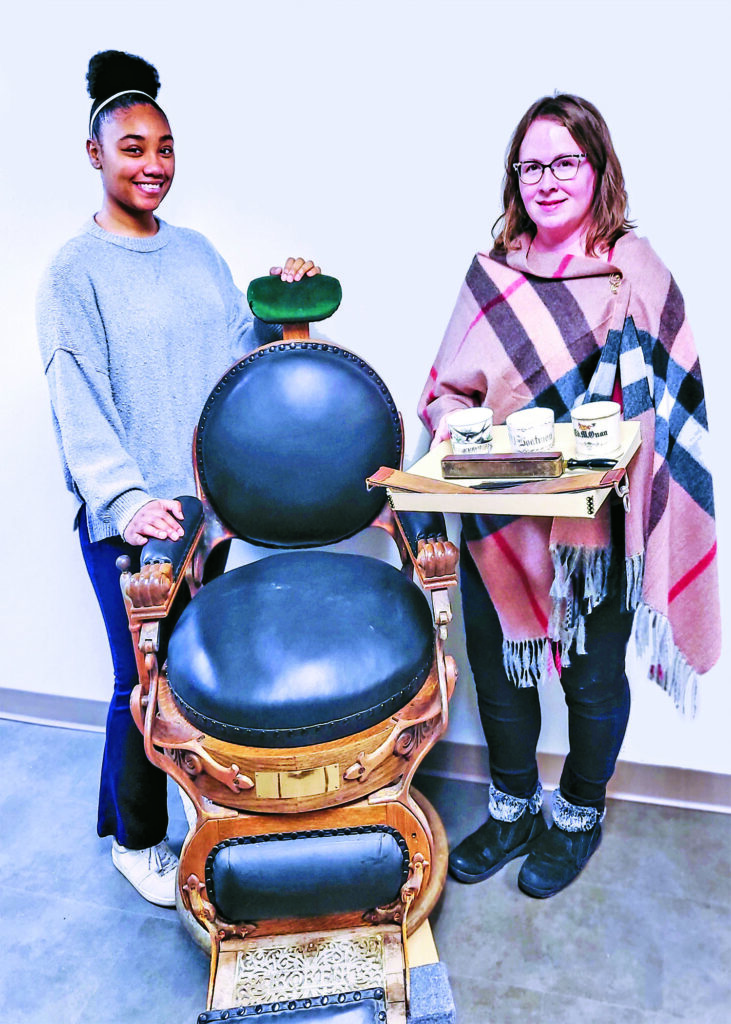
Gabby Clavo and Lisa Vedaa of HCSCC show off mementos of the early barbershops of Fargo and Moorhead — a reclining barber chair, shaving mugs and razors. Half of the cities’ “tonsorial artists” of the late 1800s were African-American professionals.
Nancy Edmonds Hanson
When historian Markus Krueger began exploring the story of Civil War veteran Felix Battles, perhaps the first Black resident of Moorhead, he came across a fascinating but largely forgotten fact: About half of the barbers in Moorhead and Fargo were, in the early days, African American professionals.
Battles, who arrived to work on the Northern Pacific Railroad in the early 1870s, became Moorhead’s first barber or, in the elegant verbiage of his day, the earliest “tonsorial artist.” Digging further, the program director of the Historical and Cultural Society of Clay County found that his successful business wasn’t an anomaly. “Barbering was one of the very few professional careers available to African Americans,” he explains. “They could make a good living, own their own business and be respected as professionals.
“And African American men were considered to be the best barbers.”
The stories of Battles and his peers – including Julius Taylor, proprietor of Fargo’s largest barber shop, Taylor’s Tonsorial Palace, and Frank Gordon, who ran for Fargo city alderman in1900 – became the genesis of the exhibit that opens later this month in the Hjemkomst Center. “Stories of Local Black History” will debut March 22 and remain on display through Oct. 9.
“There was never a time there were no Black people in this community,” Krueger emphasizes. The African American newspaper published in St. Paul, the Appeal, recounted the stories of social life here along the Red River. Its social columns recounted elegant parties among the elite, often children of those Black tonsorial artists, who enjoyed bicycle club excursions, attended balls, and hosted soirees in their homes.
The local Black community flourished in early Moorhead and Fargo, Krueger says, perhaps reaching its zenith in the 1890s. “An era of optimism followed the Civil War,” the historian reflects. “People were coming here, like other cities, to find opportunities to own business and build better lives for their families.”
But starting in the 1920s, the Great Migration of Black men and women from the South to well-paying manufacturing jobs in the Midwest and North inspired many to echo that move, relocating to the Twin Cities for employment in its booming industrial sector.
The HCSCC exhibit embodies much of the prosperity and promise of those days. But that’s not the end of its scope. Among the residents in the spotlight is Cordelia Bloundt, who graduated from Moorhead High School in 1927 and went on to a distinguished academic career at Georgia State University. Vermont-born Fenwick Watkins was that state’s first African American football captain. He he coached sports teams for Fargo College, NDSU and Concordia into the 1920s, then retired from coaching to focus on being a real estate.
The influx of African Americans resumed 60 years ago. “It had a lot to do with the colleges,” the historian says. Concordia College, Moorhead State College and North Dakota State University all recruited Black students, as well as faculty members. Among them: James and Yvonne Condell, who became legendary professors at MSC – he of psychology, she of biology.
James Condell, who had served in the ground crew of the famed Tuskegee Airmen, was as famous for his classical and jazz guitar as his teaching. His guitar will be featured in the upcoming exhibit, along with six and one-half hours of his digitized music, which will provide its soundtrack.
When U.S. refugee policy changed in the 1990s, immigrants from Africa began arriving in Moorhead, both through the resettlement efforts of Lutheran Social Services and through what Krueger terms “secondary migration,” when their relatives who had originally moved to other parts of the country relocated to the thriving local community. Their variety of cultures – South Sudan, Liberia, Nigeria, Somalia, Ghana and Ivory Coast – is also reflected among the Black stories in the exhibit.
Uncovering the stories has been a rewarding hunt for Krueger and colleagues Lisa Vedaa, Emily Kulzer and Gabby Calvo. “You find one paragraph in this book, one and a half pages in that one, an item in a newspaper – you find a thread and then you follow it,” he points out. “It’s rewarding to collect these bits and pieces, then put them all in one place to tell the larger story.”


